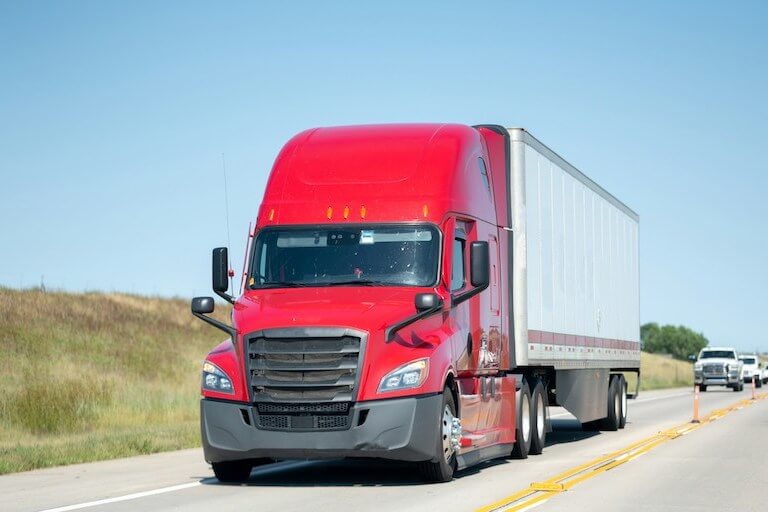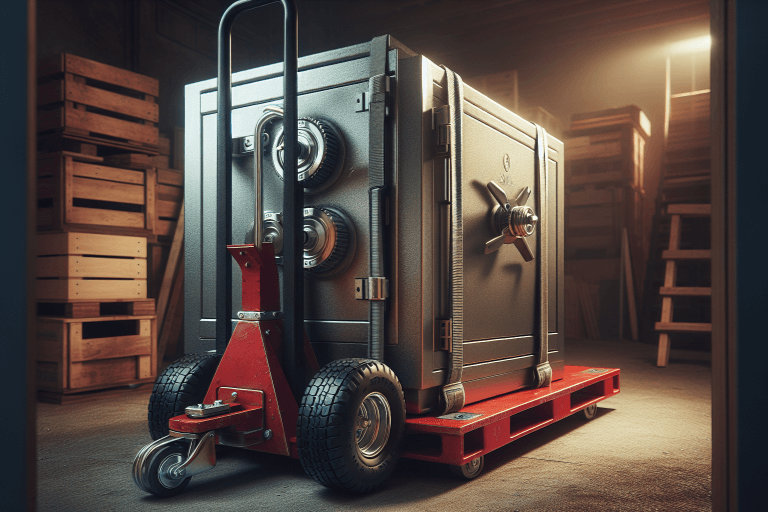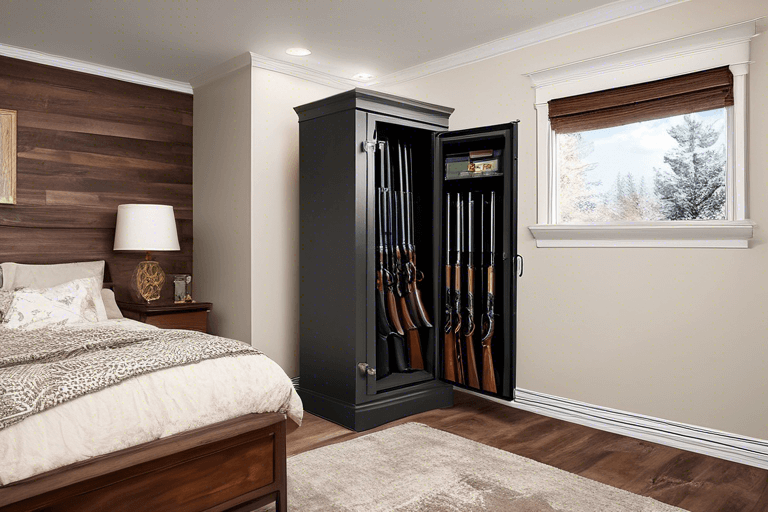
Where to Put a Gun Safe in Your Home
Table of Contents
- Assessing Security Priorities
- Balancing Accessibility and Security
- Environmental Factors and Climate Control
- Structural Considerations and Weight Distribution
- Integrating with Home Security Systems
- Considering Fireproofing and Disaster Preparedness
- Addressing Legal and Insurance Considerations
- Making the Optimal Choice for Your Needs
- Frequently Asked Questions
The placement of your gun safe is not a decision to be taken lightly. It requires careful consideration of multiple factors, including security, accessibility, environmental conditions, and structural support.
This decision impacts not only the security of your firearms but also their accessibility and longevity.
In this comprehensive guide, we'll explore the various factors to consider when determining the ideal placement for your gun safe, ensuring maximum protection, convenience, and preservation of your valuable firearms.
Assessing Security Priorities
When it comes to positioning your gun safe, security should be your foremost concern. The primary purpose of a gun safe is to prevent unauthorized access to your firearms, protecting them from theft and ensuring they don't fall into the wrong hands.
Choose a Low-Traffic Area
One of the first considerations in maximizing security is to select a location with minimal foot traffic.
Areas of your home that see less activity are inherently more secure, as they reduce the chances of the safe being noticed by visitors or potential intruders.
Some options to consider include:
- A dedicated storage room
- A secluded corner of a basement
- A rarely-used spare bedroom
- A hidden alcove in a master bedroom closet
By placing your gun safe in a less frequented area, you decrease the likelihood of drawing unwanted attention to its presence.
Balancing Accessibility and Security
While security is paramount, it's equally important to ensure that you can access your firearms quickly when needed.
You want to striking the right balance between security and accessibility.
Evaluating Your Home's Layout
Consider your home's floor plan and your daily routines when deciding on a location. Ideally, your gun safe should be:
- Close enough to access quickly in an emergency
- Far enough from main living areas to maintain privacy
- In a location that allows for discreet access
- Positioned to minimize the risk of discovery by children or guests
Analyze your home's layout and identify areas that meet these criteria while aligning with your security priorities.
Considering Different Access Scenarios
Think about various situations in which you might need to access your firearms. This could include:
- Home defense scenarios
- Preparing for hunting trips
- Routine cleaning and maintenance
- Transporting firearms to and from the range
Ensure that your chosen location accommodates these different access needs without compromising security.
Utilizing Quick-Access Options
For situations where rapid access is important, consider incorporating quick-access safes or lockboxes in strategic locations throughout your home. These can complement your main gun safe and provide immediate access to a firearm in emergency situations.
Environmental Factors and Climate Control
The environment in which you place your gun safe can significantly impact the condition of your firearms over time.
Factors such as humidity, temperature fluctuations, and exposure to the elements can lead to rust, corrosion, and other forms of damage.
Avoid Moisture-Prone Areas
Moisture is one of the biggest threats to firearm integrity. When selecting a location for your gun safe, steer clear of areas prone to high humidity or water exposure, such as:
- Basements with poor waterproofing
- Bathrooms or laundry rooms
- Areas near water heaters or plumbing fixtures
- Garages or outdoor sheds in humid climates
If you must place your safe in an area with potential moisture issues, invest in a quality dehumidifier and regularly monitor humidity levels inside the safe.
Maintaining Consistent Temperature
Extreme temperature fluctuations can cause condensation inside your gun safe, leading to rust and other issues. Avoid placing your safe in areas subject to significant temperature changes, such as:
- Attics or crawl spaces
- Uninsulated garages
- Near heating vents or radiators
- In direct sunlight
Opt for a location with a stable, moderate temperature to help preserve your firearms' condition.
Implementing Climate Control Solutions
To further protect your firearms from environmental factors, consider:
- Installing a gun safe dehumidifier
- Using moisture-absorbing products inside the safe
- Regularly inspecting and cleaning your firearms
- Investing in a climate-controlled safe for optimal protection
By addressing environmental concerns, you can significantly extend the life and maintain the value of your firearms.
Structural Considerations and Weight Distribution
Gun safes are typically heavy, with some models weighing several hundred pounds or more.
Proper structural support is essential to ensure the safety of your firearms and prevent damage to your home. This is especially important to consider if you want to put your gun safe upstairs in a second-story room.
Assessing Floor Strength
Before deciding on a location, evaluate the strength of the floor in that area. Consider factors such as:
- The age and condition of the building
- The type of flooring material (concrete, wood, etc.)
- The presence of support beams or joists
- Any existing structural issues in the home
For upper floors or areas with questionable support, consult a structural engineer to determine if additional reinforcement is necessary.
Distributing Weight Effectively
To minimize stress on your home's structure, consider ways to distribute the weight of your gun safe effectively:
- Place the safe perpendicular to floor joists rather than parallel
- Use a steel plate or plywood sheet under the safe to spread the load
- Position the safe near load-bearing walls or support columns
- Avoid placing the safe in the center of a room, where the floor may have less support
Proper weight distribution can prevent damage to your floors and ensure the long-term stability of your gun safe.
Planning for Installation and Future Moves
When selecting a location, also think about how you'll get the safe into position and whether you might need to move it in the future. Consider:
- Doorway widths and hallway turns
- Staircase dimensions and weight capacity
- The possibility of using a professional moving service
- Whether the safe can be disassembled for easier transport
Choosing a location for your guns safe that allows for relatively easy installation and potential future relocation can save you significant hassle and expense.
Integrating with Home Security Systems
Your gun safe should be an integral part of your overall home security strategy. By coordinating its placement with your existing security measures, you can create a more robust defense against theft and unauthorized access.
Leveraging Existing Security Infrastructure
When deciding where to place your gun safe, consider how it can benefit from your current security setup:
- Position the safe within view of security cameras
- Place it in an area covered by motion sensors
- Ensure it's within range of your home alarm system
By integrating your gun safe with existing security measures, you create multiple layers of protection for your firearms.
Coordinating with Professional Monitoring Services
If you use a professional monitoring service for your home security, discuss the placement of your gun safe with them. They may have specific recommendations or protocols for monitoring high-value storage areas like gun safes.
Considering Fireproofing and Disaster Preparedness
While protecting your firearms from theft is crucial, it's equally important to consider their safety in the event of a fire or natural disaster.
The location of your gun safe can play a significant role in its ability to withstand these events.
Evaluating Fire Risks
When choosing a location for your gun safe, assess the fire risks in different areas of your home:
- Avoid placing the safe near potential fire sources (e.g., kitchens, fireplaces)
- Consider the building materials in different areas of your home
- Evaluate the proximity to fire suppression systems or extinguishers
- Think about the ease of access for firefighters in an emergency
Positioning your safe in an area with lower fire risk can provide an extra layer of protection for your firearms.
Implementing Additional Fire Protection
To enhance the fire resistance of your gun safe:
- Choose a location away from flammable materials
- Consider installing a fire suppression system in the room housing the safe
- Use fire-resistant building materials in the area surrounding the safe
- Invest in a safe with a high fire rating for maximum protection
Remember that while many gun safes offer some level of fire protection, their effectiveness can be greatly enhanced by thoughtful placement and additional precautions.
Planning for Natural Disasters
Depending on your location, you may need to consider the risk of natural disasters such as floods, earthquakes, or hurricanes. When selecting a spot for your gun safe:
- Avoid basement locations in flood-prone areas
- Ensure proper anchoring in earthquake-prone regions
- Re-consider upper-floor placement in hurricane-risk zones
- Plan an evacuation strategy that includes securing or relocating your firearms
By factoring in potential natural disasters, you can better protect your firearms and ensure their security in various emergency scenarios.
Addressing Legal and Insurance Considerations
The location of your gun safe can have implications for both legal compliance and insurance coverage. It's important to consider these factors when deciding where to place your safe.
Complying with Local Regulations
Some jurisdictions have specific requirements for firearm storage. When choosing a location:
- Research local laws regarding gun storage
- Ensure your chosen location meets any mandated security standards
- Consider visibility and access restrictions if required by law
- Document your compliance for legal protection
Adhering to local regulations not only keeps you on the right side of the law but can also provide guidance on best practices for safe placement.
Maximizing Insurance Coverage
Your insurance policy may have specific requirements or limitations regarding firearm storage. To optimize your coverage:
- Review your homeowner's or renter's insurance policy
- Discuss gun safe placement with your insurance agent
- Consider additional policies for high-value firearms
- Document your safe's location and security measures for claims purposes
Proper placement and documentation can help ensure full coverage in the event of theft, damage, or loss.
Planning for Liability Protection
The location of your gun safe can also impact your liability in the event of unauthorized access or accidents. Consider:
- Placing the safe in a secure, adult-only area of the home
- Implementing additional security measures in homes with children
- Ensuring all household members are educated on gun safety
- Maintaining clear documentation of your storage practices
By carefully considering liability issues, you can reduce risks and protect yourself legally.
Making the Optimal Choice for Your Needs
Ultimately, the goal is to have a gun storage solution that provides maximum security for your firearms, ensures they remain in excellent condition, and allows for appropriate access when needed.
By thoroughly evaluating the security, accessibility, environmental conditions, structural considerations, and legal implications of a give location, you can make an informed choice that best protects your firearms and aligns with your lifestyle.
Invest the necessary time and effort into finding the optimal location for your gun safe, and you'll enjoy the peace of mind that comes with knowing your firearms are secure, protected, and properly stored for years to come.
Frequently Asked Questions
Where not to put a gun safe?
It's not recommended to put a gun safe in a master bedroom, as this is often the first place criminals will search for valuables.
Should a gun safe be in a closet?
A gun safe can be placed in a closet for quick access during emergencies, such as home fires or earthquakes. It provides a secure location for important belongings.
Do I need to put anything under my gun safe?
Yes, it's a good idea to put a thin piece of carpet under your gun safe to distribute its weight and protect your floor from damage. However, avoid using a rubber mat on linoleum as it can leave permanent marks.



